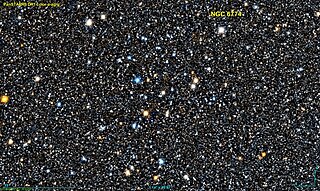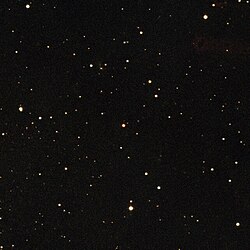
The Beehive Cluster, is an open cluster in the constellation Cancer. One of the nearest open clusters to Earth, it contains a larger population of stars than other nearby bright open clusters holding around 1,000 stars. Under dark skies, the Beehive Cluster looks like a small nebulous object to the naked eye, and has been known since ancient times. Classical astronomer Ptolemy described it as a "nebulous mass in the breast of Cancer". It was among the first objects that Galileo studied with his telescope.
The Hungarian Automated Telescope Network (HATNet) project is a network of six small fully automated "HAT" telescopes. The scientific goal of the project is to detect and characterize extrasolar planets using the transit method. This network is used also to find and follow bright variable stars. The network is maintained by the Center for Astrophysics | Harvard & Smithsonian.
HAT-P-11, also designated GSC 03561-02092 and Kepler-3, is an orange dwarf metal rich star about 123 light-years away in the constellation Cygnus. This star is notable for its relatively large rate of proper motion. The magnitude of this star is about 9, which means it is not visible to the naked eye but can be seen with a medium-sized amateur telescope on a clear dark night. The age of this star is about 6.5 billion years.

Ruprecht 147 or NGC 6774 is a dispersed star cluster in the Milky Way galaxy. It is about 1,000 light years away, which is close to Earth in comparison with other such clusters. In late summer, it can be seen with binoculars in the constellation of Sagittarius. The stars, bound by gravity, are about 2.5 to 3.25 billion years old. The cluster, discovered in 1830 by John Herschel, was sometimes thought to be an asterism due to its sparseness and location against the background of the richest part of the Milky Way, and also since the brightest stars in this old cluster perished long ago. In 1966 the Czech astronomer Jaroslav Ruprecht classified it as a type III 2 m open cluster under the Trumpler scheme. It received otherwise little attention until 2012, when it was identified as a potentially important reference gauge for stellar and Galactic astrophysics research, particularly the research of Sun-like stars.
K2-3, also known as EPIC 201367065, is a red dwarf star with three known planets. It is on the borderline of being a late orange dwarf/K-type star, but because of its temperature, it is classified as a red dwarf.
GJ 9827 is a star in the constellation of Pisces. It is a K-type main-sequence star with an apparent magnitude of 10.250. It is 97 light-years away, based on parallax.

HD 179070, also known as Kepler-21, is a star with a closely orbiting exoplanet in the northern constellation of Lyra. At an apparent visual magnitude of 8.25 this was the brightest star observed by the Kepler spacecraft to host a validated planet until the discovery of an exoplanet orbiting HD 212657 in 2018. This system is located at a distance of 354 light-years from the Sun based on parallax measurements, but is drifting closer with a radial velocity of −18.2 km/s.
K2-19 is an early K-type or late G-type main sequence star that is magnetically active, and has a light curve that exhibits variations in brightness of ~1%. It is located approximately 976 light-years away in the constellation Virgo. Three confirmed transiting exoplanets are known to orbit this star.
K2-28 is a metal rich M4-type main sequence star. One confirmed transiting exoplanet is known to orbit this star. There is another star 5.2 arcseconds to the north–east of K2-28 however this star has a different proper motion and is therefore physically unrelated and probably a background star.
K2-32 is a G9-type main sequence star slightly smaller and less massive than the sun. Four confirmed transiting exoplanets are known to orbit this star. A study of atmospheric escape from the planet K2-32b caused by high-energy stellar irradiation indicates that the star has always been a very slow rotator.
K2-315b is an exoplanet located 185.3 light years away from Earth in the southern zodiac constellation Libra. It orbits the red dwarf K2-315.




